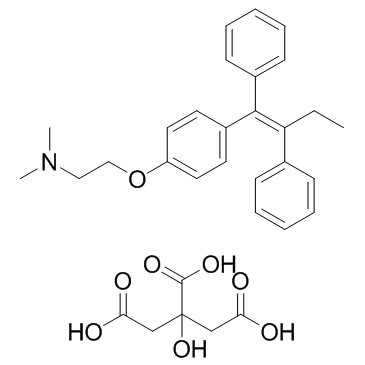Tamoxifen citrate

Tamoxifen citrate structure
|
Common Name | Tamoxifen citrate | ||
|---|---|---|---|---|
| CAS Number | 54965-24-1 | Molecular Weight | 563.638 | |
| Density | N/A | Boiling Point | 665.9ºC at 760 mmHg | |
| Molecular Formula | C32H37NO8 | Melting Point | 140-144 °C | |
| MSDS | Chinese USA | Flash Point | 356.5ºC | |
| Symbol |


GHS07, GHS08 |
Signal Word | Danger | |
|
TGF-beta receptor type-2 expression in cancer-associated fibroblasts regulates breast cancer cell growth and survival and is a prognostic marker in pre-menopausal breast cancer.
Oncogene 34(1) , 27-38, (2015) Transforming growth factor-beta (TGF-β) is a pleiotropic cytokine with the capability to act as tumour suppressor or tumour promoter depending on the cellular context. TGF-beta receptor type-2 (TGFBR2) is the ligand-binding receptor for all members of the TGF... |
|
|
Comparison of tamoxifen and letrozole response in mammary preneoplasia of ER and aromatase overexpressing mice defines an immune-associated gene signature linked to tamoxifen resistance.
Carcinogenesis 36(1) , 122-32, (2015) Response to breast cancer chemoprevention can depend upon host genetic makeup and initiating events leading up to preneoplasia. Increased expression of aromatase and estrogen receptor (ER) is found in conjunction with breast cancer. To investigate response or... |
|
|
Exposure to the polyester PET precursor--terephthalic acid induces and perpetuates DNA damage-harboring non-malignant human breast cells.
Carcinogenesis 36(1) , 168-76, (2015) Identification of early perturbations induced in cells from non-cancerous breast tissue is critical for understanding possible breast cancer risk from chemical exposure. We have demonstrated previously that exposure to the ubiquitous xenoestrogens, bisphenol ... |
|
|
Chronic centrosome amplification without tumorigenesis.
Proc. Natl. Acad. Sci. U. S. A. 112 , E6321-30, (2015) Centrosomes are microtubule-organizing centers that facilitate bipolar mitotic spindle assembly and chromosome segregation. Recognizing that centrosome amplification is a common feature of aneuploid cancer cells, we tested whether supernumerary centrosomes ar... |
|
|
Comparative uterotrophic effects of endoxifen and tamoxifen in ovariectomized Sprague-Dawley rats.
Toxicol. Pathol. 42(8) , 1188-96, (2014) Endoxifen (4-hydroxy-N-desmethyl-tamoxifen), one of the major active metabolites of tamoxifen, has substantially greater estrogen antagonist properties and antiproliferative effects in breast tumor cells than tamoxifen, a mixed estrogen agonist/antagonist. An... |
|
|
Non conventional biological treatment based on Trametes versicolor for the elimination of recalcitrant anticancer drugs in hospital wastewater.
Chemosphere 136 , 9-19, (2015) This work presents a study about the elimination of anticancer drugs, a group of pollutants considered recalcitrant during conventional activated sludge wastewater treatment, using a biological treatment based on the fungus Trametes versicolor. A 10-L fluidiz... |
|
|
Tracing the fate of limbal epithelial progenitor cells in the murine cornea.
Stem Cells 33(1) , 157-69, (2014) Stem cell (SC) division, deployment, and differentiation are processes that contribute to corneal epithelial renewal. Until now studying the destiny of these cells in a living mammal has not been possible. However, the advent of inducible multicolor genetic t... |
|
|
Overcoming endocrine resistance due to reduced PTEN levels in estrogen receptor-positive breast cancer by co-targeting mammalian target of rapamycin, protein kinase B, or mitogen-activated protein kinase kinase.
Breast Cancer Res. 16(5) , 430, (2015) Activation of the phosphatidylinositol 3-kinase (PI3K) pathway in estrogen receptor α (ER)-positive breast cancer is associated with reduced ER expression and activity, luminal B subtype, and poor outcome. Phosphatase and tensin homolog (PTEN), a negative reg... |
|
|
Stable self-assembled nanostructured hen egg white lysozyme exhibits strong anti-proliferative activity against breast cancer cells.
Colloids Surf. B Biointerfaces 130 , 237-45, (2015) Chemotherapy side effects have long been a matter of great concern. Here we describe a structurally stable self-assembled nanostructured lysozyme (snLYZ) synthesized using a simple desolvation technique that exhibited anticancer activity, as well as excellent... |
|
|
Critical roles for nitric oxide and ERK in the completion of prosurvival autophagy in 4OHTAM-treated estrogen receptor-positive breast cancer cells.
Cancer Lett. 353(2) , 290-300, (2014) Autophagy is a mechanism of tamoxifen (TAM) resistance in ER-positive (ER+) breast cancer cells. In this study, we showed in ER+ MCF7 cells that 4-hydroxytamoxifen (4OHTAM) induced cellular nitric oxide (NO) that negatively regulates cellular superoxide (O2-)... |